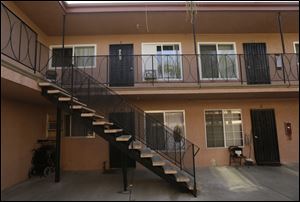
Police say kidnapped California woman's mother recently convinced her to go to authorities
5/22/2014
The home of suspect Isidro Garcia, the top floor, apartment "G" is photographed in Bell Gardens, Calif., on Wednesday, May. 21, 2014. Garcia was arrested Wednesday for allegedly kidnapping a 15-year-old girl in Santa Ana in 2004 then repeatedly physically and sexually assaulting her over the course of 10 years. He was booked for kidnap for rape, and lewd acts with a minor and false Imprisonment. (AP Photo/Damian Dovarganes)
ASSOCIATED PRESS

The home of suspect Isidro Garcia, the top floor, left apartment "G" is photographed in Bell Gardens, Calif.
SANTA ANA, Calif. — A woman who disappeared a decade ago as a 15-year-old reunited recently with her mother, who convinced her to go to authorities to report that she had been kidnapped and raped by a man who is now her husband and father of her daughter.
Orange County prosecutors today filed five felony charges against the alleged abductor, Isidro Garcia, including rape and kidnapping to commit a sexual offense. He did not enter a plea, and his arraignment was continued until June. He is being held on $1 million bail.
Police described an ordeal during which the now 25-year-old woman — broken through mental, physical and sexual abuse — was moved at least four times and given multiple fake identities to hide her from family and authorities.
The woman, who police did not identify by name, said she often thought about escaping but stayed out of fear, even though in recent years she was not physically held captive. She told police that Garcia said her mother was not looking for her and that if she contacted authorities, her family would be deported.
Then, in April, the woman got in touch with her mother after finding her sister on Facebook to wish her a happy birthday, Santa Ana Police Cpl. Anthony Bertagna said.
The mother showed the daughter news articles written at the time of her 2004 disappearance to prove that she had gone to the police and filed a missing-persons report, according to Bertagna.
“The mother was able to show her that she was, in fact, looking for her,” Bertagna said.
The woman said in a television interview that she was overjoyed to be reunited with her family.
“I was very afraid about everything because I was alone,” she told KABC-TV.
When reached by phone by The Associated Press, the woman’s mother said she had no comment because police told her not to speak with media.
Police said that the woman, who they did not identify, had arrived in the U.S. from Mexico several months before her abduction and did not speak English at the time.
On Monday, she contacted police in the working-class city of Bell Gardens to report a domestic violence incident with Garcia. During that investigation, authorities realized her connection to the 2004 case.
Garcia forced the woman to marry in 2007 and fathered a daughter, now 3, with her, Santa Ana police said.
In Bell Gardens — near Los Angeles and about 20 miles from where she originally vanished — stunned neighbors who knew the suspect as Tomas Medrano found the woman’s portrait of him hard to reconcile with the man they knew.
“He treats her like a queen. He does his best to do whatever she wants,” next-door neighbor Maria Sanchez said Wednesday in Spanish after police announced Garcia’s arrest.
The woman told the station that her neighbors believed Garcia was a good man because he provided for her.
“He worked hard for me and my daughter, and he bought everything I want. But I didn’t want that,” she said with her mother, sister and daughter at her side. “I need love from my family, not things.”

Cpl. Anthony Bertagna, Public Information Officer for the Santa Ana Police Department.
Bertagna said his department’s investigation concluded the following:
The girl arrived from Mexico in February 2004 to join her mother and sister in Santa Ana, about 30 miles southeast of downtown Los Angeles. She had entered the United States illegally.
Garcia was her mother’s boyfriend. After one fight between the girl’s mother and Garcia in August 2004, the girl’s mother left the house and the girl went to a nearby park.
Garcia followed the girl. When he caught up with her, she said she had a headache and wanted to go home.
“He told her then, ‘You can’t go home. You’re here illegally. You don’t speak the language. Your mom’s called the police. They will send you back. I’m your only hope,‘” Bertagna said.
Garcia gave her five pills that he said would help her headache but instead knocked her out. When the girl awoke, she was locked in a garage in Compton, a city between Santa Ana and Los Angeles.
The mother “filed a police report and for 10 years (police) did due diligence. But they were changing their names and dates of birth and physical locations so that made it exceedingly difficult,” Bertagna said.
In 2007, Garcia got documents from Mexico that gave the girl a new name and date of birth. Using those documents, he married her at a courthouse.
Police said the woman tried to escape twice but was severely beaten.
Elizabeth Smart, who was kidnapped from her Utah bedroom at 14 and held captive for nine months, told The Associated Press that people cannot know what victims are going through and should not question why the woman didn’t escape sooner.
“We don’t know what these evil people are holding over them — whether it’s their families’ lives, their lives, whatever it is,” Smart said.
Marisa Cianciarulo, a law professor at Chapman University, said immigrants who came to the United States illegally are vulnerable to certain kinds of manipulation.
“The threat that ‘I am going to get your family deported’ is a very real threat,” Cianciarulo said. “Any interaction with law enforcement, whether it is federal, local, can be seen as very threatening and frightening to undocumented immigrants.”
In addition, small acts of kindness — a bit of food, permission to use the bathroom — can create positive feelings within the victim that the captor then exploits, said Dr. Frank Ochberg, an expert on the psychology of captives.
Garcia lived in Bell Gardens for about four years. The family had the second-floor corner unit of a stucco apartment building in a quiet neighborhood across from a park.
Neighbors said Garcia always said hello, joked with neighbors and sometimes brought them fruit. His wife worked for a nearby janitorial service, and he held at least two jobs — including one making egg rolls — and also collected cardboard and recyclable items to sell.
Garcia said he wanted to save money so that his wife didn’t have to work, said Lourdes Hernandez, who baby-sat their child for a year.
The family threw elaborate parties that included costumed characters and raffle giveaways. A video taken at their daughter’s birthday party last year shows the mother with the girl in her arms, line-dancing behind her husband as he wiggles his hips.
Hernandez said the woman took Zumba classes in South Los Angeles and sometimes invited her along. She said she found the woman’s story hard to believe.
“He worked hard for her,” she said.
Neighbors said the family took trips together to Disneyland and the beach, and even up north to visit Garcia’s family.
“I’m astounded she waited so long to say something,” said Rita Salazar, who lived across the street from the couple.